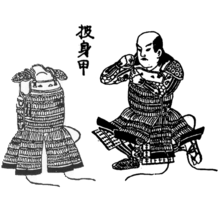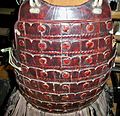- Dō (armour)
-
Dou or dō (chest armour or cuirass) are one of the major components of Japanese armour worn by the samurai class and foot soldiers (ashigaru) of feudal Japan.
Contents
History
The predecessor of the samurai dou (dō) was manufactured in Japan as early as the 4th century.[1]tankō, worn by foot soldiers and keikō, worn by horsemen were both pre-samurai types of early Japanese cuirass constructed from iron plates connected together by leather thongs.
During the Heian period (794 to 1185) the Japanese cuirass evolved into the more familiar style of armour worn by the samurai known as the dou or dō. Japanese armour makers started to use hardened leather (nerigawa) along with iron in their armour construction and lacquer (urushi) was used to weather proof the armor parts. By the end of the Heian period the Japanese cuirass had arrived at the shape recognized as being distinctly samurai. Leather and or iron scales were used to construct samurai armours, with leather and eventually silk lace used to connect the individual scales (kozane) which these cuirasses were now being made from.[2]
In the 16th century Japan began trading with Europe during what would become known as the Nanban trade. Samurai acquired European cuirasses which they modified and combined with domestic armour as it provided better protection from the newly-introduced matchlock muskets known as Tanegashima. The introduction of the tanegashima by the Portuguese in 1543[3]along with a change in battle tactics caused the Japanese armour makers to change the design of the dou (dō) from the centuries old lamellar armours to plate armour constructed from iron and steel plates, this type of armour was called tosei gusoku (new armours).[4]Bullet resistant dou (dō) were developed, this type of armour was called tameshi gusoku (bullet tested)[5]allowing samurai to continue wearing their armour despite the use of firearms.
The warfare of the Sengoku period (15th and 16th centuries) required large quantities of armour to be produced for the ever growing armies of foot soldiers (ashigaru). Simple munition quality (okashi or lent)[6]dou or dō were massed produced including tatami dou (dō) which could be folded. [7]
The era of warfare called the Sengoku period ended around 1600, Japan was united and entered the peaceful Edo period, samurai continued to use both plate and lamellar dou (dō) as a symbol of their status but traditional armours were no longer necessary for battles. During the Edo period light weight, portable and secret hidden armours became popular as there was still a need for personal protection. Civil strife, duels, assassinations, peasant revolts required the use of tatami dou (dō) as well as kusari katabira (chain armour jackets) and armoured sleeves as well as other types of armour which could be worn under ordinary clothing.[8]Edo period samurai were in charge of internal security and would wear various types of kusari gusoku (chain armour) and shin and arm protection as well as forehead protectors (hachi-gane).[9]
Dou (dō) and other armour continued to be worn and used in Japan until the end of the samurai era (Meiji period) in the 1860s, with the last use of samurai armour happening in 1877 during the satsuma rebellion.[10]
Types of dou (dō)
Kozane dou (dō)
Kozane dou (dō) are of lamellar construction using individual scales known as kozane, they were old fashioned armours used before the introduction of firearms in Japanese warfare, (pre-Sengoku styles)[11][12]
Kozane dou (dō) gallery
Tosei dou (dō)
Tosei dou (dō) (tosei meaning modern), were made from iron plates ita-mono[13] instead of individual scales kozane. Tosei-gusoku became prominent starting in the 1500s due to the advent of fire arms, new fighting tactics and the need for additional protection.[14][15]
Tosei dou (dō) gallery
Tatami dou (dō)
Tatami dou (dō) (folding or foldable) were made from small rectangular (karuta) or hexagon (kikko) armour plates that were usually connected to each other by chain armour (kusari) and sewn to a cloth backing, tatami dou (dō) could also be made entirely from kusari.[16]Tatami dou (dō) were lightweight, portable, convenient for transportation, and were manufactured inexpensively and in great numbers for the ashigaru light inf(antry.[17]Tatami dou (dō) were worn by all samurai classes from the highest class to the lowest class. The higher class samurai wore elaborate tatami dou (dō)[18]while the lower class samurai and retainers wore plain basic tatami dou (dō).
Tatami dou (dō) gallery
References
- ^ Sacred texts and buried treasures: issues in the historical archaeology of ancient Japan, William Wayne Farris, University of Hawaii Press, 1998 P.75
- ^ Oriental Armour, H. Russell Robinson, Courier Dover Publications, 2002 P.i73
- ^ Tanegashima: the arrival of Europe in Japan, Olof G. Lidin, Nordic Institute of Asian Studies, NIAS Press, 2002
- ^ Samurai: The Weapons and Spirit of the Japanese Warrior, Clive Sinclaire, Globe Pequot, 2004 P.32
- ^ The Watanabe Art Museum Samurai Armour CollectionVolume I ~ Kabuto & Mengu, Trevor Absolon P.78
- ^ The Watanabe Art Museum Samurai Armour Collection Volume I — Kabuto & Mengu, Trevor Absolon P.130
- ^ Samurai: The Weapons and Spirit of the Japanese Warrior, Clive Sinclaire, Globe Pequot, 2004 P.29
- ^ Secrets of the samurai: a survey of the martial arts of feudal Japan, Oscar Ratti, Adele Westbrook, Tuttle Publishing, 1991 P.196
- ^ Taiho-jutsu: law and order in the age of the samurai, Don Cunningham, Tuttle Publishing, 2004 P.46
- ^ Samurai: The Weapons and Spirit of the Japanese Warrior, Clive Sinclaire, Globe Pequot, 2004 P.58
- ^ Japan's ancient armour, Hatiro Yamagami, Japan. Kokusai Kankōkyoku, Board of Tourist Industry, Japanese Government Railways, 1940
- ^ Japan's ancient armour, Hatiro Yamagami, Japan. Kokusai Kankōkyoku, Board of Tourist Industry, Japanese Government Railways, 1940
- ^ Oriental Armour, H. Russell Robinson, Courier Dover Publications, 2002 p.190
- ^ Samurai: The Weapons and Spirit of the Japanese Warrior, Clive Sinclaire, Globe Pequot, 2004, p.32
- ^ Samurai: The Weapons and Spirit of the Japanese Warrior, Clive Sinclaire, Globe Pequot, 2004, p.171
- ^ Samurai 1550-1600, Anthony J. Bryant, Angus McBride, Osprey Publishing, 1994 P.31
- ^ Samurai 1550-1600 by Anthony J. Bryant, Angus McBride, p.59
- ^ The samurai: warriors of medieval Japan, 940-1600, Anthony J. Bryant, Angus McBride, Osprey Publishing p.63
External links
Categories:
Wikimedia Foundation. 2010.










